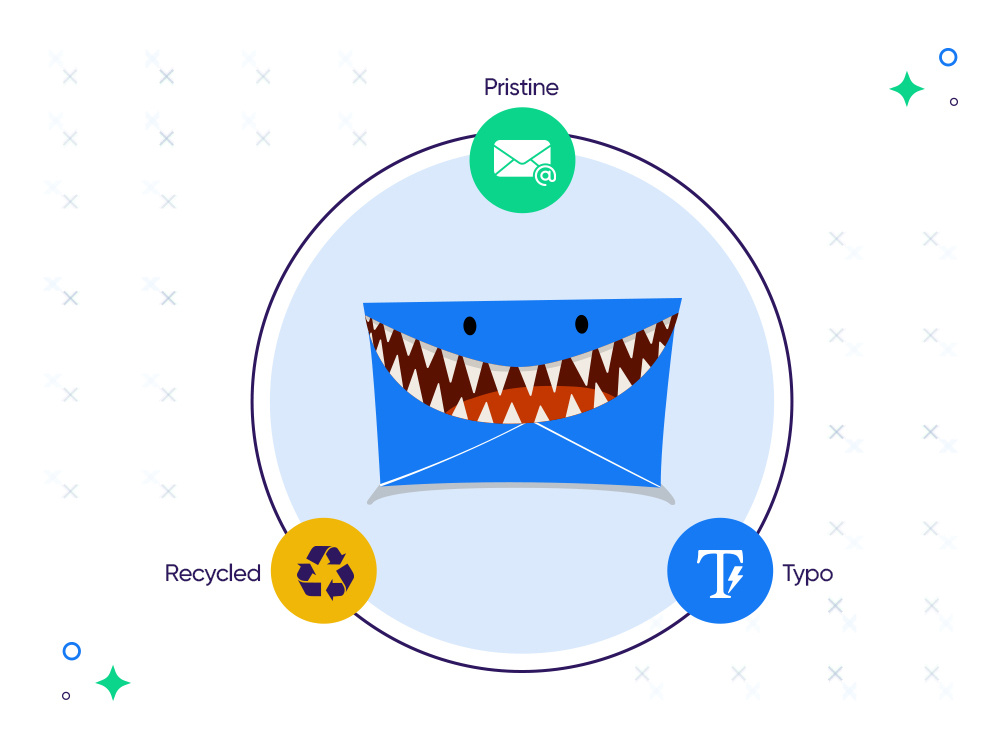In email marketing, one challenge looms large: spam traps. These innocuous-looking email addresses can wreak havoc on your sender reputation and email deliverability if left unchecked. But fear not, intrepid marketer. With the right knowledge and strategies, you can navigate this minefield and emerge with your email campaigns intact and thriving.
Table of Contents
The Silent Saboteurs: Understanding Spam Traps
What are spam traps? Spam traps are email addresses used by Internet Service Providers (ISPs), blacklist operators, and anti-spam organizations to identify and monitor spam. They look just like regular email addresses, but they serve a singular purpose: to catch senders who aren’t following email best practices.
Think of spam traps as the silent sentinels of the email world. They don’t belong to real people, and they’re not used for communication. Their sole job is to catch unwary or unscrupulous senders and flag them as potential spammers.
The impact of hitting a spam trap can be severe and immediate. Your sender reputation—that all-important score that determines whether your emails land in the inbox or the spam folder—can take a nosedive. In some cases, your IP address or even your entire domain could be blocklisted, effectively shutting down your email marketing efforts.
The Triad of Traps: Pristine, Recycled, and Typo

Not all spam traps are created equal. Understanding the different types can help you identify their sources and implement targeted prevention strategies.
1. Pristine Traps: The Purest Form of Deception
Pristine traps are the most dangerous type. These email addresses are created solely to catch spammers and have never been used for legitimate purposes or subscribed to any mailing list.
ISPs and anti-spam organizations place these addresses on public websites, often hidden in the code, where only automated scrapers or purchased lists would find them.
If you hit a pristine trap, it’s a clear sign of questionable list-building practices. The consequences can be immediate and severe, often leading to blocklisting.
2. Recycled Traps: From Legitimate to Lethal
Recycled traps begin as genuine email addresses. After prolonged inactivity (usually 6–12 months), ISPs repurpose them into traps.
These are designed to catch senders who neglect proper list hygiene. If you continue emailing inactive contacts beyond a year, you risk hitting recycled traps and damaging your sender reputation.
3. Typo Traps: The Devilish Details
Typo traps target common misspellings like “gmial.com” instead of “gmail.com” or “yaho.com” instead of “yahoo.com.”
These traps catch senders who don’t verify email addresses or who manually guess address formats. While less damaging than pristine traps, consistently hitting typo traps will erode your sender reputation over time.
Unmasking the Imposters: How to Identify Spam Traps
Identifying spam traps is not a straightforward task—after all, they’re designed to blend in with legitimate email addresses. However, there are several strategies you can employ to sniff them out:
Monitor Engagement Metrics: Spam traps never engage. Look for addresses that have never opened or clicked your emails.
Analyze Bounce Patterns:Watch for hard bounces. A previously valid address that begins bouncing may be transitioning into a recycled trap.
Scrutinize Sign-Up Patterns:Be cautious of sudden spikes in new sign-ups from unfamiliar sources. This can indicate list scraping.
Implement Email Verification: Use verification tools at the point of collection to detect typos and non-existent addresses.
Segment and Test: Create a re-engagement campaign targeting inactive users. Unresponsive addresses could be spam traps.
The goal isn’t just to remove spam traps but to understand how they entered your list. This insight helps refine your acquisition and maintenance processes.
The Ounce of Prevention: Strategies to Avoid Spam Traps
The Ounce of Prevention: Strategies to Avoid Spam Traps
Preventing spam traps from entering your list is far more effective than trying to remove them later. Here’s how to keep your list clean and compliant:
Implement Double Opt-In
Double opt-in is your first line of defense. It requires new subscribers to confirm their subscription via email, ensuring the address is valid and owned by a real person.
Regular List Cleaning
Schedule routine list cleanups. Remove hard bounces immediately and delete subscribers who haven’t engaged in 6–12 months. A smaller, engaged list is more valuable than a large, inactive one.
Use Real-Time Email Verification
Deploy verification tools across all collection points—website forms, landing pages, or offline events—to catch invalid or mistyped addresses early.
Monitor Your Sender Reputation
Tools like SenderScore or SpamAssassin Check help assess how mailbox providers view your sending behavior. A sudden drop in score may signal spam trap hits.
Avoid Purchasing Email Lists
Never purchase lists. They’re often filled with spam traps and violate most ESPs’ terms of service. Build your list organically for quality and trust.
Implement a Sunset Policy
Define a clear inactivity threshold (e.g., 6–12 months). Send a re-engagement campaign before removing disengaged users. This prevents recycled traps from lingering on your list
The Road to Recovery: What to Do If You Hit a Spam Trap
Despite your best efforts, you might still encounter a spam trap. Don’t panic. Follow these steps:
Stop Sending Immediately: Pause all campaigns to prevent further damage.
Identify the Source: Determine which segment or acquisition method led to the issue.
Clean Your List: Conduct a thorough cleanup and remove inactive or unverified addresses. Examine your list-building and maintenance practices for weaknesses.
Gradually Resume Sending: Restart with your most engaged subscribers, then slowly increase sending volume.
Monitor Closely: Watch deliverability metrics, bounce rates, and open rates as you recover.
Recovery takes time. The focus should be on rebuilding trust with ISPs and improving your overall sending practices.
Stay Vigilant, Stay Delivered
Spam trap management is an ongoing process requiring vigilance, best practices, and consistent maintenance. By implementing the strategies outlined in this guide, you can protect your sender reputation and maintain high deliverability.
Your email list is one of your most valuable marketing assets. Treat it with care, respect your subscribers, and prioritize quality over quantity. Doing so will help you build a responsive, healthy email list that drives real results.
Elevate Your Email Marketing: Why SendX is Your Ultimate Spam-Fighting Ally

In the battle against spam traps and deliverability challenges, SendX stands out as your trusted partner. Our comprehensive platform offers an arsenal of tools designed to keep your email list clean and your campaigns soaring.
From advanced email verification that catches typos before they become traps, to powerful segmentation tools that help you identify and engage your most active subscribers, SendX has you covered. Our double opt-in functionality ensures your list stays pristine, while our robust analytics help you spot potential spam traps lurking in your inactive segments.
But we don't stop there - SendX also provides deliverability consulting, dedicated IPs for high-volume senders, and seamless integrations to supercharge your email marketing strategy. With SendX, you're not just avoiding spam traps; you're building a resilient, high-performing email program that drives real results for your business.
Ready to transform your email marketing and say goodbye to spam trap worries? Start your free trial with SendX today and experience the power of intelligent email marketing!
